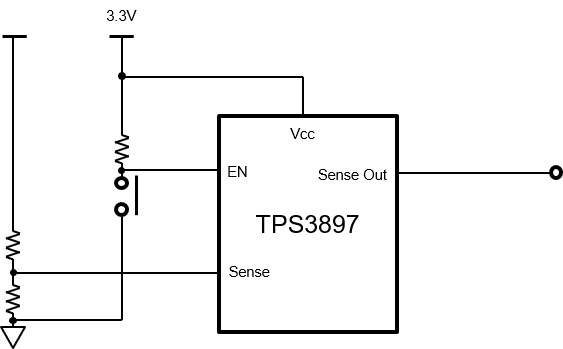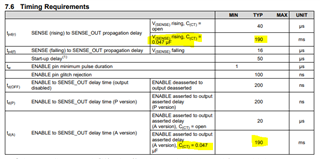Hi Team,
My customer is wondering if Enable pin of TPS3897 can be used for manual reset now.
Do you have any concerns such the following use case?

Regards,
Takashi Onawa
This thread has been locked.
If you have a related question, please click the "Ask a related question" button in the top right corner. The newly created question will be automatically linked to this question.
Hi Team,
My customer is wondering if Enable pin of TPS3897 can be used for manual reset now.
Do you have any concerns such the following use case?

Regards,
Takashi Onawa
Hi Takashi,
Thank you for your question, yes the enable pin for this device can be used similar to a manual reset. The main difference is that EN does not have a set time to keep SENSEOUT asserted. So the amount of time SENSEOUT stays asserted is the time spent by EN on low. No additional concern for this use case.
Jesse
Hi Jesse-san,
Thank you for your prompt response on this. I understood that the pin can be used for manual reset.
I'm a little bit confused about the recovery time from releasing /EN. let me double check about the period.
According to the datasheet, 7.6 Timing Requirements, it looks tpd(r) and td(A) shows same period. So I thought td(A) is calculated as below. Is this understanding correct?
td(A) (s) = [CCT (µF) × 4] + 40 µs
Regards,
Takashi Onawa
HI Takashi-san,
For the EN pin, the SENSEOUT stays low while EN pin is low plus the Td(A) duration.
Jesse
Hi Jesse-san,
Thank you for your prompt response on this.
I want to know how we can calculate Td(A) period as well. Can we use same equation as tpd(r)?
Regards,
Takashi Onawa
HI Takashi-san,
The td(A) and td(r) should be using the same equation for calculation, but before we move forward with this I just need to check with the designer, because the equation provided does not match with the DS values and what I have observed when I tested today.

From the DS, the example shows that they used a .047uF cap on the CT and they got a 190ms delay, but if you plug the .047uF on the provided equation you only get roughly around 40us. I tested this set up on my EVM and observed the 190ms delay with the .047uF.
I will need to talk to the designer to get clarification on this.
Jesse
Hi Takashi,
I just got the clarification. Td(A) = Td(r) = (C(uF)x4) + 40x10^(-6) = delay in seconds.
The thing that created my confusion was that the C(uF)x4 is units of seconds already.
Sorry for the delay.
Jesse
Hi Jesse-san,
Thank you for your confirmation on this.
OK, I understood that Td(A) = Td(r).
Regards,
Takashi Onawa